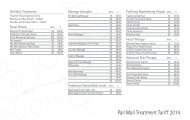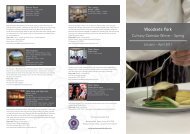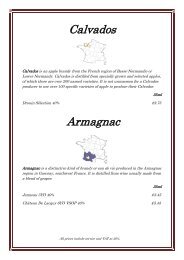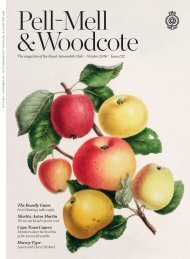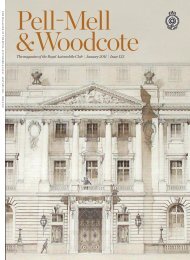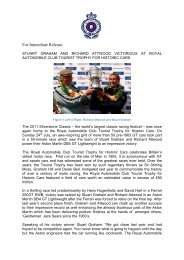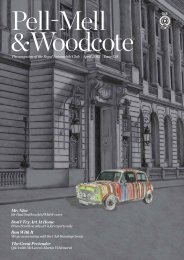October 2011 - Royal Automobile Club
October 2011 - Royal Automobile Club
October 2011 - Royal Automobile Club
You also want an ePaper? Increase the reach of your titles
YUMPU automatically turns print PDFs into web optimized ePapers that Google loves.
When I took up<br />
scuba diving my<br />
father was frank in<br />
his advice: ‘Don’t<br />
drown Sarah.’ He said. So I suppose<br />
it was to be expected when, on<br />
informing him that I was off to<br />
follow a pheasant shoot, his words<br />
of wisdom were similarly candid:<br />
‘Don’t get shot Sarah’. It hadn’t<br />
occurred to me that I might be on<br />
the receiving end of a twelve bore;<br />
so on the morning of the shoot, I<br />
find myself, loitering by a table piled<br />
high with bacon sandwiches,<br />
wearing a pair of B&Q Wellingtons<br />
with mild trepidation. The bacon<br />
sandwich table is surrounded. Men<br />
in tweed are all munching away,<br />
warming up before they strike out<br />
for this shooting party at Consall<br />
Valley. The shoot, owned by<br />
member Martin Pointon, is in the<br />
wilds of Staffordshire where the mix<br />
of woodland and moors makes for<br />
perfect pheasant country. Pheasants<br />
from the Consall Valley Shoot will<br />
be on tables in the club from now<br />
until January.<br />
The ShooTing ParTy<br />
I meet club member Chris Hogg,<br />
bacon sandwich in hand. Chris has<br />
been kind enough to let me come<br />
along and be the Butch Cassidy to<br />
his Sundance Kid for the day. At<br />
least I hope his shooting skills<br />
compare to the Sundance Kid – I<br />
am after all attempting to avoid<br />
getting shot. Chris has already<br />
drawn his peg, the position in the<br />
line of eight guns on the first drive,<br />
this position then moves along two<br />
pegs each drive. In shooting there’s<br />
48 <strong>October</strong> <strong>2011</strong> | Issue 136<br />
a reassuring ‘does what it says on<br />
the tin’ quality to the language. Not<br />
only a weapon, a gun is one of the<br />
people doing the shooting. A loader<br />
is someone who loads the gun. A<br />
drive describes the way in which the<br />
birds are driven towards the guns. A<br />
picker up is someone, usually with a<br />
Springer Spaniel or two, who<br />
collects the birds once they have<br />
been shot. ‘Once we are on the peg<br />
we are live.’ says Chris, as we line up<br />
with the other guns in a clearing in<br />
the woods. There is a silence, made<br />
more acute by the ear defenders I<br />
have been given. Then, through the<br />
trees, I can hear the clattering and<br />
calling of the beaters, a pack of stick<br />
and flag wielding folk who advance<br />
through the wood in a line flushing<br />
out the pheasants towards the guns.<br />
The birds are upon us, flapping<br />
through the air, shots ring out from<br />
pegs further down the line. As a bird<br />
flies in our direction Chris raises his<br />
gun, he tracks the bird’s line of flight<br />
and fires two shots into the air. I<br />
cheer silently as the pheasant makes<br />
his escape. There’s a flurry of<br />
activity to reload the gun once each<br />
of the barrels is spent. A second bird<br />
flies overhead. This one isn’t so<br />
lucky. I cheer for Chris silently: this<br />
pheasant business creates rather<br />
divided loyalties. A third bird comes<br />
our way, this time much lower in the<br />
sky, a veritable sitting duck of a<br />
pheasant, but Chris doesn’t even<br />
pull the trigger. ‘Its important not to<br />
take low birds’ he says, ‘there’s no<br />
sport in it’.<br />
The guns shoot and reload. The<br />
pheasant fly into range: some are<br />
shot and plummet to the earth with<br />
a dull thud; others live to flap<br />
another day. After around 40<br />
minutes a whistle signals the end of<br />
the drive and whilst the picker ups<br />
finish collecting the birds, the guns<br />
congregate for a congratulatory<br />
snifter of alcohol, all pleased with<br />
the spoils of the first drive. With<br />
relief I accept a soupçon of Baileys<br />
in my coffee, Chris appears to know<br />
what he is doing and I have, for the<br />
moment, evaded death.<br />
Fair game<br />
The ringmaster of all this beating,<br />
shooting and picking up is Ray<br />
Edge, gamekeeper at Consall Valley.<br />
Even though the season starts on 1<br />
<strong>October</strong>, Ray works year round to<br />
make the shoots happen. Young<br />
pheasants, known as poults, are<br />
reared in pens dotted around the<br />
woods for two to three weeks. They<br />
are weaned on wheat before being<br />
released into the wild at the end of<br />
July. The pheasants are then kept in<br />
the boundaries of the shoot by a<br />
process know as dogging in. ‘I go out<br />
with the dogs at first light and walk<br />
the perimeter of the shoot’, says<br />
Ray. ‘We do it three times a day<br />
from July to September, I must walk<br />
around 20 miles a day’. With the<br />
season underway Ray organises<br />
each shoot day, as well passing the<br />
birds on to game dealers.<br />
<strong>Club</strong> PheaSanT<br />
Pheasant from Consall Valley is<br />
bought up by butcher to the club<br />
Finclass. Not only is Chris Hogg my<br />
Sundance Kid, he runs Finclass<br />
with his father Gordon, who is also a<br />
member of the club. ‘Most game



